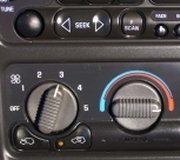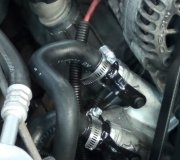The best way I have found to find coolant leaks is to full the system to capacity and pressurize the system using compressed air when the engine is cool / cold. That way, any leaking coolant ends up as liquid outside the place it is leaking, rather than as vapor (such as from a hot engine leaking a tiny bit of coolant - - it vaporizes as fast as it leaks out). And I don't mean using lots of compressed shop air. All you need is about 5 to 10 pounds of pressure. That is equivalent to the radiator hose being just hard to squeeze by hand. In other words, squeeze the radiator hose with zero pressure in the system. You should get the hose completely flat by hand. Now put 8 pounds pressure and squeeze by hand. It should feel real tight.
So how do you get those 8 Lbs of pressure in there? Keep the radiator cap tightly secured. Just under the radiator cap there is an overflow tube. Disconnect the overflow tube/hose at the overflow resovoir and use the same hose to pump in air pressure. It doesn't have to be fancy. Use a bicycle tire air pump or anything similar to force air into the little orifice under the radiator cap. Once you get some pressure in there, make sure the pressure doesn't escape out the same hose you just pumped air into. You'll need to plug the hose with your finger or something.
Now, patience. Feel the radiator hose on occasion. If the large hose is easier to squeeze as time goes by, you know pressure is escaping some place. If pressure is escaping, there should be some coolant associated with it, ending up in a water drip some place.
Regarding the extended time req'd to build up any heat from the air vents, your heater core may be clogged. This depends on how well the cooling system has been maintained. If at any time your coolant looked muddy or smelled like rotton fish during the 144,000 miles, your heater core may be clogged. Just flushing the radiator won't solve the problem. The heater core needs to be disconnected from the rest of the sytem and flushed seperately. Depending on the extent of sediment, this may not be the solution. You may need another heater core.
But before dishing out money for another heater core, start the engine from a "cold" start, turn on the vent setting with heat ON full and feel the temperature of the 3/4" hoses running from and to the heater core. The hoses should build up heat, faster than the upper radiator hose. If both hoses are hot (within about 1 minute of engine running) that means you have reasonable coolant flow, hence. May NOT have a clogged heater core.
If one hose is hot, and the other one is notably cooler, your heater core may be clogged because the hot water is trying to make its way into the heater core, it's travelling slowly thru it (water is losing all its heat during the time within) and by the time it reaches the "out" hose, all the hot water has lost its heat and the hose feels lots cooler than the scalding-hot other neighboring 3/4" heater hose.
Which brings me to my last suggestion. If you have good water flow thru the 3/4" hoses as verified by the last paragraph (both 3/4" hoses are notably hot), check the air-blend-door for proper motion. You'll need to crouch down under the passenger-side dashboard / kick panel, remove some plastic cover plates, and look for the lever(s) which control the airflow thru the a/c - heater plenum. Make sure the lever(s) move thru their full range of motion. You'll need to experiment with the temperature control knob and view the lever(s) as they move.
Good Luck.
Tuesday, February 17th, 2009 AT 8:29 PM


